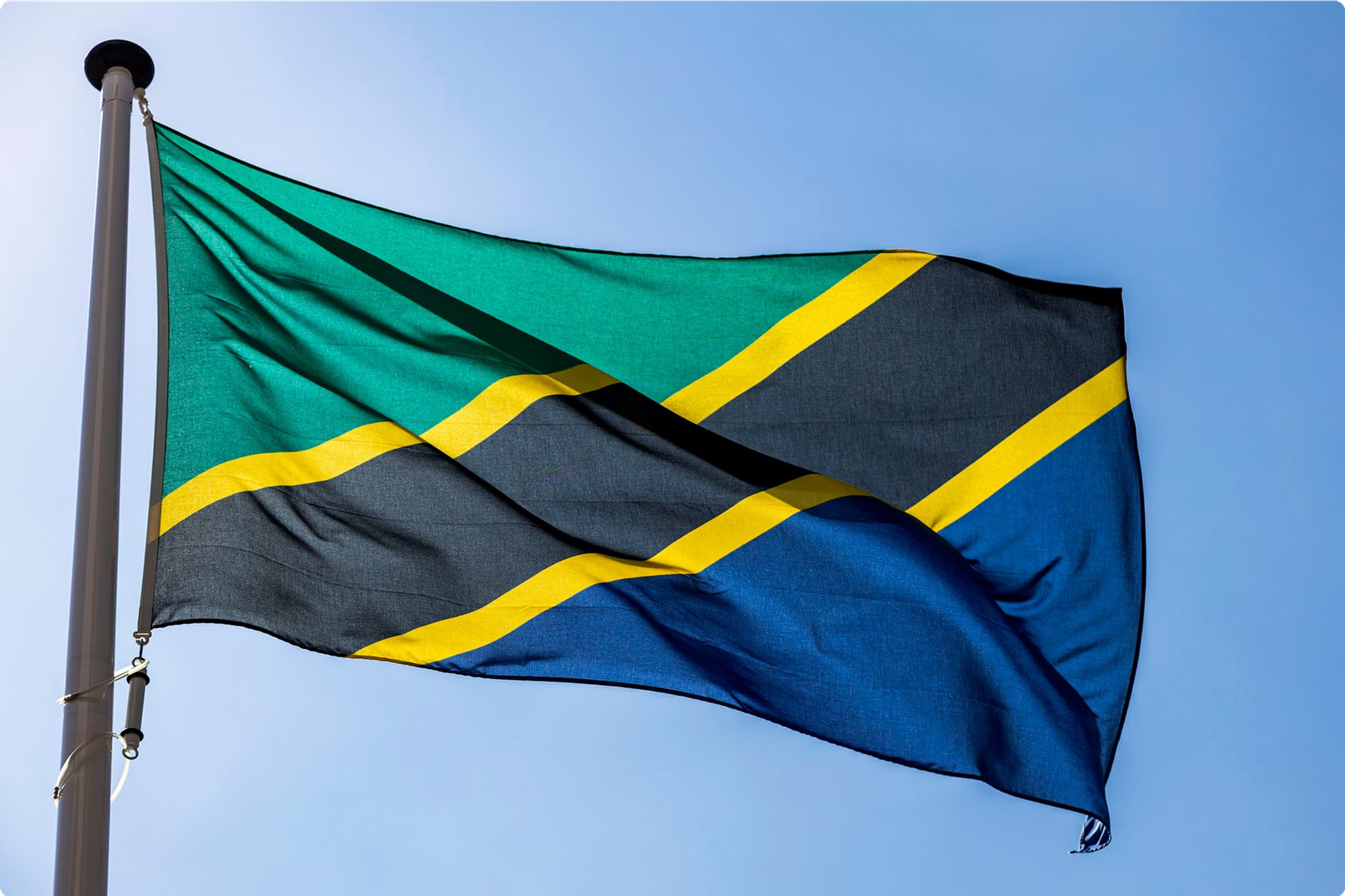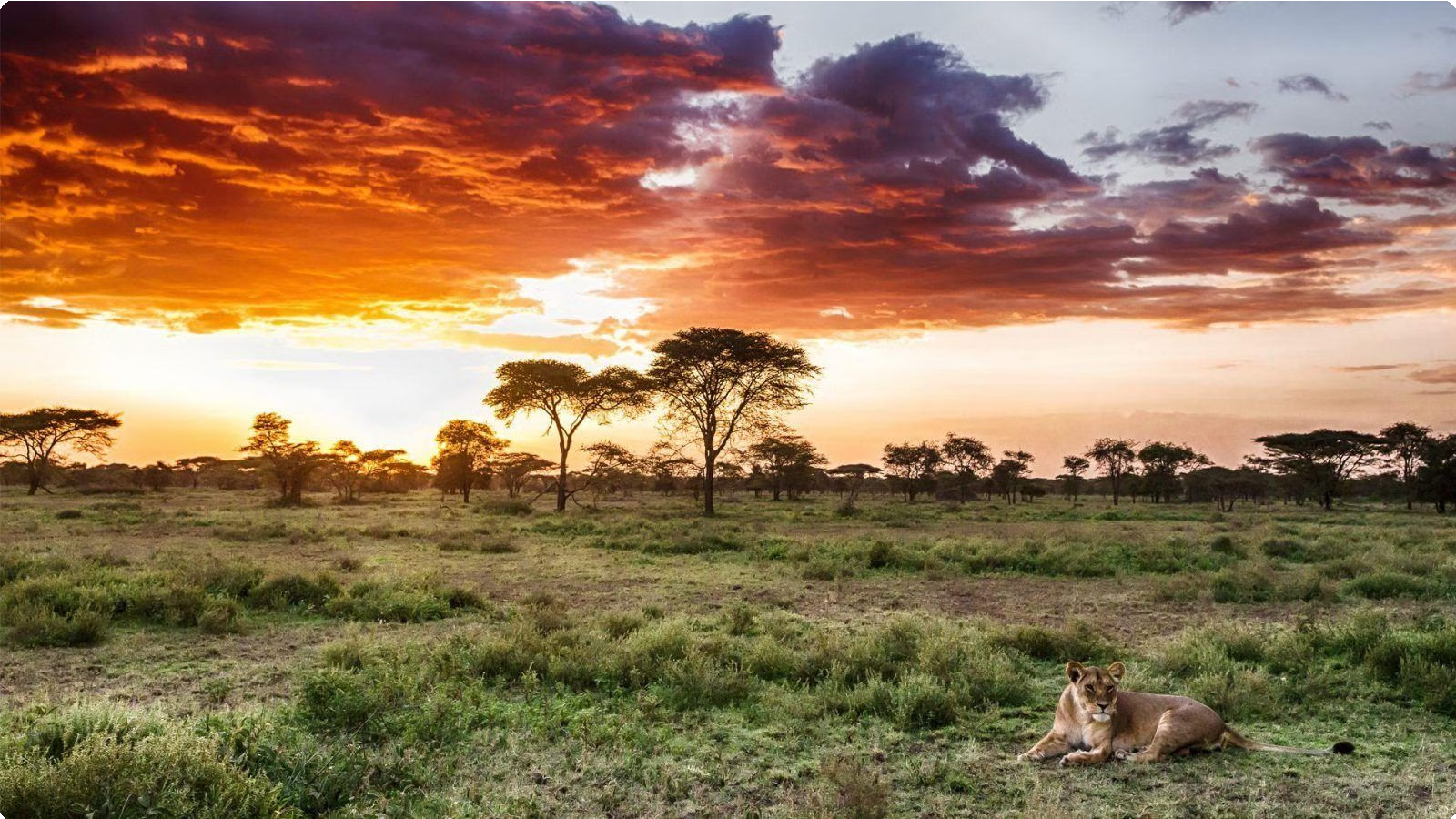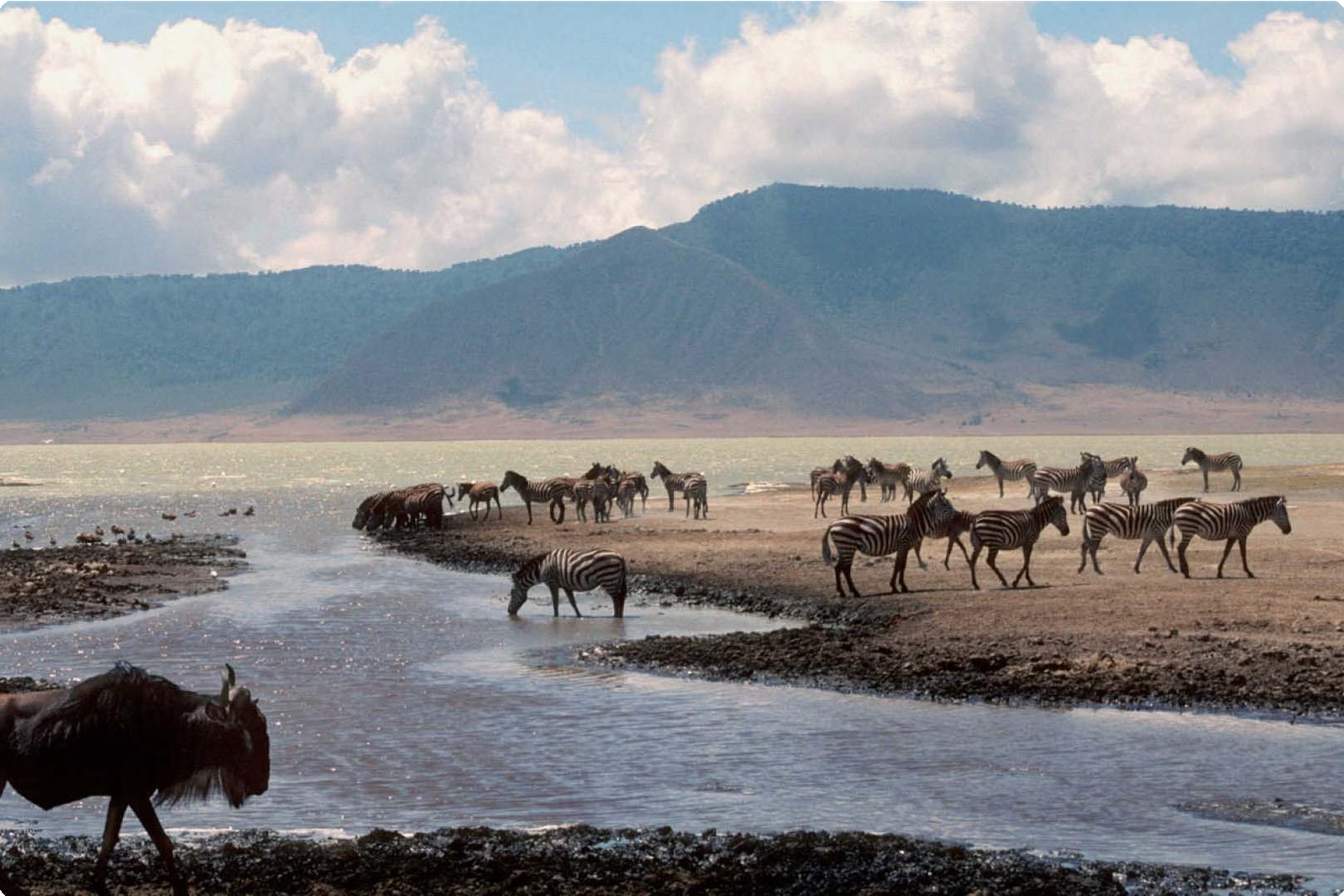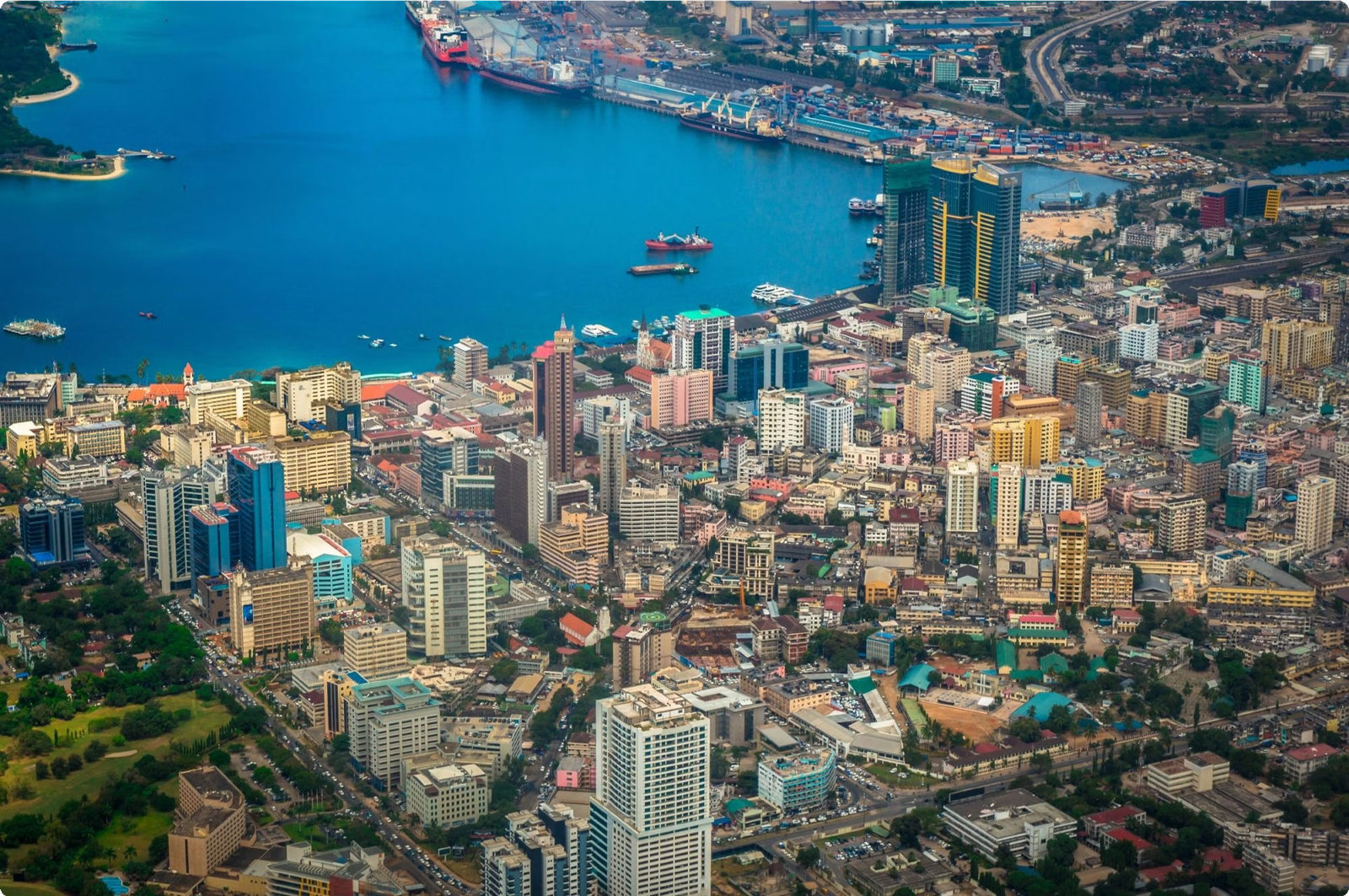Tanzania
Discover Tanzania
Tanzania, a country in East Africa, is known for its diverse culture, stunning landscapes, and rich history. From the iconic Mount Kilimanjaro to the beautiful beaches of Zanzibar, Tanzania offers a wide array of natural attractions. The vibrant traditional music, dance, and art reflect the colorful heritage of the Tanzanian people. With a unique blend of Swahili, Arabic, and European influences, Tanzania’s culture is a captivating mix of traditions and customs.

National Flag and Coat of Arms
Tanzania’s national flag consists of a horizontal tricolor of green, gold, and black, representing the country’s lush vegetation, mineral wealth, and its people. In the center of the flag, there is a large yellow- edged black band, symbolizing the people of Tanzania and the land itself. The coat of arms features a warrior’s shield and spears, with the national motto, “Uhuru na Umoja” (Freedom and Unity) inscribed on it.

The flag and coat of arms embody the country’s rich history, culture, and aspirations. They are powerful symbols of national unity, independence, and the values cherished by the Tanzanian people.
Geography and Map
Tanzania is located in East Africa and is bordered by eight countries. It is known for its diverse landscapes, including the snow-capped Mount Kilimanjaro, the Serengeti plains, and the tropical beaches of Zanzibar. The country is home to Africa’s highest and lowest points, with Mount Kilimanjaro towering at 5,895 meters and Lake Tanganyika reaching depths of 1,470 meters. The geographical features offer unique opportunities for adventure tourism, wildlife safaris, and beach vacations.

The map of Tanzania includes the mainland and the islands of Zanzibar and Pemba. The mainland is characterized by a central plateau, a highland region, and the Great Rift Valley. The coastline, with its palm-fringed beaches and coral reefs, adds to the country’s scenic beauty. Tanzania’s geography plays a vital role in shaping its climate, flora, fauna, and cultural diversity, making it a fascinating destination for travelers.
Currency and Economy
Tanzania’s official currency is the Tanzanian Shilling (TZS). The economy of Tanzania is mainly based on agriculture, which accounts for a significant portion of the country’s GDP. Major exports include coffee, cashew nuts, tobacco, and cotton. In recent years, Tanzania has also seen growth in tourism, telecommunications, and mining sectors, contributing to the country’s economic development. The government has been focusing on improving infrastructure, attracting foreign investments, and promoting economic stability.

The country has been making efforts to increase industrialization and diversify the economy, aiming to reduce its reliance on agriculture. Tanzania is part of the East African Community, fostering regional economic cooperation and trade. Despite facing challenges, including poverty and infrastructure constraints, Tanzania’s economy has shown resilience and potential for growth.
Culture and Traditions
Tanzania is known for its rich and diverse culture, influenced by over 120 different ethnic groups. The country’s culture is a blend of various traditions, art, music, dance, and cuisine, making it a fascinating and vibrant destination for travelers. One of the prominent aspects of Tanzanian culture is its traditional clothing, such as the colorful and intricately designed “Kanga” and “Kitenge” fabrics, each with its own symbolic meanings and patterns.
The Tanzanian people also celebrate various festivals and ceremonies, including the lively “Makonde Festival” and the traditional “Chagga Wedding” rituals, which showcase the community’s strong bonds and traditions. Music and dance play an integral role in Tanzanian culture, with popular styles like “Bongo Flava” and “Taarab” captivating audiences with their rhythmic beats and expressive movements.
Moreover, traditional storytelling and folklore are cherished in Tanzanian communities, with tales of bravery, wisdom, and mythical creatures passed down through generations. Additionally, the warm hospitality and welcoming nature of the Tanzanian people contribute to the rich tapestry of the country’s culture, creating lasting impressions for visitors.
Famous Tanzanian Dances
Ngoma Dance
The Ngoma dance is a traditional Tanzanian dance performed by various ethnic groups across the country. It is a high-energy dance form accompanied by pulsating rhythms and vibrant movements, depicting the rich cultural heritage of Tanzania. The dancers often wear colorful traditional attire, and the performance reflects the daily lives, rituals, and celebrations of the local communities.

Chakacha Dance
The Chakacha dance originates from the coastal region of Tanzania and is characterized by its lively and rhythmic movements. It is traditionally performed during cultural festivals and special occasions, with graceful footwork and hip-swaying motions. The dance is accompanied by melodious Swahili music, creating a captivating and festive atmosphere.
Maasai Dance
The Maasai dance is a significant cultural expression of the Maasai people in Tanzania. It is often performed during community ceremonies and social gatherings, featuring distinctive jumping and chanting patterns that symbolize strength, unity, and resilience within the community. The dance is a powerful representation of the Maasai’s deep connection to their heritage and traditions.
Traditional Tanzanian Food
Ugali and Fish Stew
Ugali is a staple food in Tanzania, made from maize flour and water. It’s often served with a flavorful fish stew, usually prepared with fresh fish and a rich blend of spices and herbs. The combination of soft, slightly grainy ugali with the hearty fish stew is a delicious and satisfying meal enjoyed by many Tanzanians.

Pilau
Pilau is a fragrant and spiced rice dish cooked with meat, vegetables, and a variety of aromatic spices such as cumin, cardamom, and cloves. It’s a popular celebratory dish in Tanzania, often served during weddings, festivals, and special events. The rich flavors and enticing aroma of pilau make it a beloved part of Tanzanian cuisine.

Mishkaki
Mishkaki consists of skewered and grilled chunks of tender meat, commonly beef or chicken, marinated in a delightful blend of spices and herbs. This flavorful street food is a favorite among Tanzanians and visitors alike, and it’s often enjoyed with a side of tangy and spicy sauces, adding an extra kick to the already delicious mishkaki.

Kachumbari
Kachumbari is a refreshing Tanzanian salad made with diced tomatoes, onions, and fresh cilantro, dressed with tangy lime juice and a sprinkle of salt. This zesty and colorful salad is a popular accompaniment to many Tanzanian dishes, adding a burst of freshness and vibrant flavors to the meal.

Famous Tanzanian Celebrities
Diamond Platnumz
Diamond Platnumz is a Tanzanian singer, songwriter, and dancer. He is best known for his hit singles and energetic performances that have gained him international recognition. With a large following in East Africa and beyond, Diamond Platnumz has played a significant role in promoting Tanzanian music on the global stage.

Flaviana Matata
Flaviana Matata is a Tanzanian fashion model who has made waves in the international fashion industry. She has graced the runways of major fashion shows and has been a source of inspiration for aspiring models in Tanzania and across the African continent.

Best Time to Visit Tanzania
The best time to visit Tanzania depends on the traveler’s preferences and the specific experiences they wish to have. The country generally experiences two distinct seasons: the dry season and the wet season. The dry season, from late June to October, is ideal for wildlife viewing, as the animals gather around water sources, making them easier to spot. Additionally, this period is perfect for trekking adventures, including climbing Mount Kilimanjaro or exploring the Ngorongoro Crater. The months of January and February are also fantastic for wildlife safaris. On the other hand, the wet season, from November to May, offers lush landscapes and bird-watching opportunities. The famous wildebeest migration in the Serengeti takes place from December to July, with calving season occurring from January to February. Travelers interested in witnessing this incredible spectacle should plan their visit accordingly. For beach enthusiasts, the dry season is ideal for visiting coastal destinations such as Zanzibar, while the wet season offers the chance to experience the unique beauty of the coastline with fewer crowds.
Top Tourist Attractions in Tanzania
Serengeti National Park
Serengeti National Park is a world-renowned wildlife sanctuary and one of the best places in Africa for game viewing. It is famous for its annual wildebeest migration, where millions of animals move across the plains in search of greener pastures, offering a breathtaking natural spectacle.
Mount Kilimanjaro
Mount Kilimanjaro, Africa’s highest peak, is a popular destination for adventurous travelers and trekkers. The diverse landscapes, ranging from tropical rainforests to alpine deserts, make this iconic mountain a must-visit for nature enthusiasts and those seeking a challenging climb.
Zanzibar Island
Zanzibar Island is a tropical paradise with pristine white sand beaches, crystal-clear waters, and a rich cultural heritage. Visitors can explore the historic Stone Town, relax on the idyllic beaches, and immerse themselves in the vibrant local culture and traditions.
Ngorongoro Conservation Area
The Ngorongoro Crater, a UNESCO World Heritage Site, is a stunning natural amphitheater and home to a diverse array of wildlife, including the densest population of lions. It offers an exceptional safari experience and the opportunity to witness the coexistence of wildlife and Maasai communities.
Serengeti National Park
Serengeti National Park, located in northern Tanzania, is renowned for its vast open plains, captivating wildlife, and breathtaking natural landscapes. It is one of the most famous national parks in Africa, attracting visitors from all over the world to witness the annual wildebeest migration, known as one of the remarkable wildlife spectacles on the planet.

The park is home to the “Big Five” – lions, elephants, leopards, rhinos, and buffaloes – along with a diverse range of other wildlife species, including giraffes, zebras, cheetahs, and various bird species. The historically rich Maasai tribe also coexists harmoniously with the park’s wildlife, adding to the cultural significance of the area.
Visitors can experience unforgettable safaris, witnessing nature in its most raw and unspoiled form, making Serengeti National Park an essential destination for nature and wildlife enthusiasts.
Mount Kilimanjaro
Mount Kilimanjaro is the highest peak in Africa and the tallest freestanding mountain on Earth. Located in Tanzania, it is a dormant volcano with three volcanic cones: Kibo, Mawenzi, and Shira. The majestic snow-capped summit is a sight to behold and a challenge for mountaineers and adventurers. The
mountain’s slopes encompass diverse ecosystems, from cultivated land to lush rainforest and alpine desert. Hiking routes like the Machame and Marangu trails offer unique experiences to trekkers, allowing them to witness the breathtaking landscapes and wildlife diversity along the way.

The local Chagga people have inhabited the area for centuries and view the mountain as a sacred site. The surrounding Kilimanjaro National Park is a UNESCO World Heritage Site, preserving the mountain’s natural beauty and ecological significance. Mount Kilimanjaro’s allure extends beyond its physical stature, representing the spirit of exploration and the enduring human endeavor to conquer nature’s grandeur.
Zanzibar Island
Zanzibar Island, also known as the “Spice Island,” is a tropical paradise off the coast of Tanzania in the Indian Ocean. The island is renowned for its stunning white sand beaches, crystal-clear turquoise waters, and rich cultural heritage. Visitors can explore the historic Stone Town, a UNESCO World Heritage Site, known for its winding alleys, bustling markets, and Arab-influenced architecture.

The island offers a perfect blend of relaxation and adventure, with opportunities for snorkeling, scuba diving, and water sports along the coast. The vibrant local culture, featuring Swahili influences and a mix of African, Arabian, and Indian traditions, adds to the allure of this enchanting destination.
Ngorongoro Conservation Area
The Ngorongoro Conservation Area is a UNESCO World Heritage site located in Tanzania. It is home to the world-renowned Ngorongoro Crater, the largest intact and unfilled caldera in the world. The conservation area encompasses diverse ecosystems, including grasslands, forests, and a soda lake that supports an array of wildlife.

One of the most iconic and breathtaking sights in the Ngorongoro Conservation Area is the Ngorongoro Crater, which is often referred to as the “eighth wonder of the world.” This natural wonder is a haven for wildlife, with the opportunity to spot the Big Five (lion, elephant, buffalo, leopard, and rhinoceros) in their natural habitat.
Visitors can also experience the Maasai culture and traditions in the conservation area, as the Maasai people coexist with the wildlife and maintain their traditional pastoralist lifestyle. The Ngorongoro Conservation Area offers unparalleled opportunities for wildlife viewing and is a must-visit destination for nature enthusiasts and safari-goers.
Lake Victoria
Lake Victoria, located in East Africa, is the largest tropical lake in the world and the second largest freshwater lake by surface area. The lake borders Tanzania, Uganda, and Kenya, making it a vital resource for the surrounding countries. Its vast waters, stretching into the horizon, provide a picturesque backdrop for both locals and tourists.

The lake has a rich ecosystem, home to various species of fish and wildlife, and is a crucial source of livelihood for the communities surrounding it. Visitors to Lake Victoria can explore its tranquil shores, experience the local culture, and partake in activities such as fishing and boat cruises. Whether it’s witnessing a breathtaking sunrise or relaxing by the peaceful waters, Lake Victoria offers a serene escape amidst natural beauty.
Tarangire National Park
Tarangire National Park is located in Tanzania and is known for its picturesque landscape, filled with ancient baobab trees and seasonal wildlife migrations. The park is home to the Tarangire River, which serves as a vital water source for the diverse range of wildlife, including large herds of elephants, wildebeest, zebras, and various bird species.

Visitors to the park can experience unique wildlife encounters and enjoy game drives to observe the fascinating behaviors of the resident animals. The park’s scenic beauty and rich biodiversity make it a must-visit destination for nature and wildlife enthusiasts.
Selous Game Reserve
Selous Game Reserve is one of the largest protected areas in Africa and is renowned for its pristine wilderness and diverse wildlife. This vast reserve is named after Frederick Courteney Selous, a British explorer and conservationist, and it is located in the southern part of Tanzania.

The reserve spans an area of about 50,000 square kilometers, making it the largest game reserve in Africa and a UNESCO World Heritage Site. Visitors to Selous Game Reserve can enjoy game drives, boat safaris along the Rufiji River, and walking safaris, offering incredible opportunities to spot elephants, lions, hippos, crocodiles, and a wide variety of bird species in their natural habitat.
Mafia Island
Mafia Island is a tropical paradise located off the coast of Tanzania in the Indian Ocean. The island is renowned for its pristine white sandy beaches, crystal-clear turquoise waters, and vibrant coral reefs, making it a perfect destination for snorkeling and diving enthusiasts. The island’s lush greenery and coconut palm-fringed coastline create a stunning backdrop for relaxation and exploration.

Visitors to Mafia Island can indulge in a range of activities, from exploring the dense mangrove forests to witnessing the traditional craftsmanship of boat building by local artisans. The island is also home to a marine national park, providing a haven for an abundance of marine life, including whale sharks, manta rays, and sea turtles.
Pemba Island
Pemba Island, also known as “The Green Island,” is an enchanting paradise located off the coast of Tanzania in the Indian Ocean. It is renowned for its lush, green landscapes, pristine beaches, and vibrant coral reefs, making it a haven for snorkeling and diving enthusiasts. The island’s rich history is evident in its ancient ruins and the famous Chwaka Bay.

The warm and welcoming local communities offer visitors an authentic cultural experience, where traditional dhows (sailing vessels) dot the horizon and markets bustle with activity. Pemba is also famed for its aromatic clove plantations, adding to its allure as an idyllic tropical escape.
Best Cities to Visit in Tanzania
Tanzania, with its diverse landscapes and rich cultural heritage, is home to several vibrant and enchanting cities that offer unique experiences for travelers. From bustling urban hubs to historic and picturesque towns, Tanzania’s cities have something to offer for every kind of traveler.

One of the top cities to visit in Tanzania is Dar es Salaam, the country’s largest city and economic hub. It boasts a lively waterfront, thriving markets, and a vibrant nightlife. Arusha, known as the gateway to the northern safari circuit, is another must-visit city, surrounded by lush coffee plantations and with a stunning view of Mount Meru. Dodoma, the capital city, offers a blend of modern and traditional architecture, along with the peaceful tranquility of its surrounding countryside. The picturesque city of Zanzibar City, with its captivating blend of Swahili and Islamic culture, is a treasure trove of history and stunning architecture. Mwanza, located on the shores of Lake Victoria, is a charming city with a relaxed atmosphere and breathtaking sunset views.
Dar es Salaam
Dar es Salaam, formerly Mzizima, is the largest city in Tanzania and an essential economic and cultural hub. Located on the eastern coast of Africa, it serves as the country’s principal port, handling a significant portion of Tanzania’s imports and exports. The city boasts a rich history, with cultural influences from Arab, German, British, and indigenous communities, making it a diverse and vibrant metropolis.

Visitors to Dar es Salaam can enjoy exploring historic sites like the National Museum and Village Museum, where they can learn about the country’s heritage through fascinating artifacts and exhibitions.
The city also offers beautiful coastal areas, such as the peaceful Kigamboni beaches and the lively waterfront of Msasani Peninsula, where locals and tourists alike gather to enjoy the stunning seaside views and vibrant atmosphere.
For those interested in local cuisine, Dar es Salaam’s food scene is a delightful blend of traditional Tanzanian flavors and international influences, with an abundance of street food vendors and upscale restaurants serving a variety of dishes. Whether it’s exploring the bustling markets or enjoying a sunset cruise along the coast, Dar es Salaam promises a memorable experience for all who visit.
This bustling city’s energy is infectious, with its bustling markets, lively music, and warm hospitality earning it a well-deserved place on any Tanzanian itinerary.
Arusha
Arusha is a vibrant city located in the northern part of Tanzania, serving as the gateway to many of the country’s most renowned national parks and natural wonders. Known as the “Safari Capital of Tanzania,” Arusha is a bustling hub for visitors seeking to explore the Serengeti, Ngorongoro Crater, and Mount
Kilimanjaro. The city itself is nestled in the shadow of Mount Meru, offering breathtaking views of Tanzania’s second-highest peak.
Arusha’s rich cultural heritage is reflected in its bustling markets, where visitors can find unique Maasai crafts, local produce, and a wide array of traditional textiles. The city also boasts a vibrant culinary scene, with an abundance of restaurants serving delicious Swahili dishes and international cuisine.
Within the city, visitors can explore the Arusha Declaration Museum, which provides insight into Tanzania’s struggle for independence and the role of the ruling party. In addition to its historical
significance, Arusha is also a major diplomatic center, hosting the East African Community headquarters and the International Criminal Tribunal for Rwanda.
Dodoma
Dodoma, officially Dodoma City, is the national capital of Tanzania. It is located in the center of the country, and it was officially designated as the capital in 1974, replacing Dar es Salaam. Dodoma enjoys a more central location, which was seen as a way to promote national unity and decentralize government functions.
The city has a blend of cultural and historical attractions, including the Bunge la Tanzania (the Parliament of Tanzania), which showcases the governance and political aspects of the country. Dodoma is also known for its vibrant markets where locals trade a variety of goods, providing a glimpse into the local economy and daily life.
The warm climate in Dodoma, characterized by dry and hot conditions, is suited for agriculture, and the city is known for its production of wine and sunflower oil. Visitors to Dodoma can explore the surrounding natural beauty, including the peaceful landscapes and wildlife reserves that offer a tranquil retreat from urban life.
Mwanza
Mwanza, located in northern Tanzania, is a bustling port city along the shores of Lake Victoria. It is the second-largest city in Tanzania and serves as a vital center for fishing and trade activities. With its picturesque views of the lake, Mwanza offers a unique blend of urban energy and natural beauty. The city is known for its vibrant markets, where locals gather to sell fresh produce, colorful fabrics, and handmade crafts.
One of the city’s prominent landmarks is the Bismarck Rock, an iconic granite outcrop that juts out into Lake Victoria, offering stunning vistas of the surrounding area. Visitors can also explore the Sukuma Museum to learn about the rich cultural heritage of the Sukuma people, who are the largest ethnic group in Tanzania.
Zanzibar City
Zanzibar City, located on the island of Unguja, is the vibrant and culturally rich capital of Zanzibar, an archipelago off the coast of Tanzania. The city is a delightful fusion of history, beauty, and diversity. Its winding alleys lined with ancient stone houses, bustling markets, and stunning architecture offer a glimpse into its captivating past.

Visitors to Zanzibar City can explore iconic landmarks such as the Sultan’s Palace, the Old Fort, and the House of Wonders, each steeped in historical significance. Beyond the historical sites, the city boasts breathtaking beaches, crystal-clear waters, and a coral reef teeming with marine life, making it a paradise for snorkeling and diving enthusiasts.
Zanzibar City’s rich cultural tapestry is further enhanced by the warm and welcoming locals, traditional music, and delectable cuisine, creating an unforgettable experience for travelers seeking an authentic and immersive cultural adventure.
Stepping into Zanzibar City feels like embarking on a journey through time, with its unique blend of influences from Africa, Arabia, India, and Europe. It truly stands as a captivating destination, offering a perfect blend of history, natural beauty, and cultural vibrancy.
Conclusion
Tanzania, with its rich and diverse culture, breathtaking landscapes, and warm-hearted people, is truly a gem waiting to be discovered. From the world-famous Serengeti National Park to the majestic Mount
Kilimanjaro, every corner of this East African country offers a unique and unforgettable experience. Whether it’s exploring the bustling streets of Dar es Salaam, indulging in the vibrant rhythms of traditional Tanzanian dances, or savoring the flavors of authentic local cuisine, Tanzania never fails to
captivate the hearts of its visitors. With its inviting blend of natural wonders and vibrant culture, Tanzania is a destination that leaves an indelible mark on all who have the privilege to visit.

As you conclude your exploration of Tanzania, a feeling of gratitude for the memories made and the beauty witnessed is inevitable. The landscapes, the people, and the experiences all come together to weave a tapestry of fond recollections that will linger long after your departure. Tanzania, with its unparalleled beauty and welcoming spirit, is more than a destination; it’s an experience that lingers in the heart and beckons for a return.